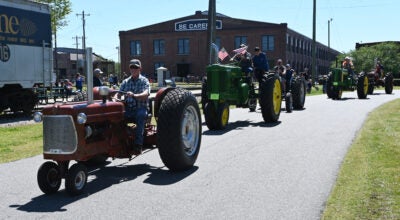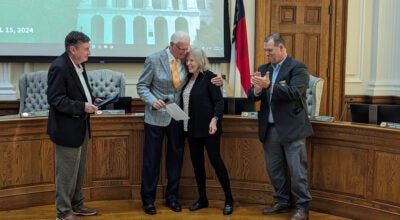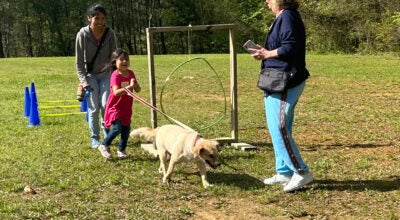Wineka column: Filmmaker of 1920s made Salisbury a star
Published 12:00 am Friday, March 11, 2011
A couple of years ago, Salisbury went bonkers when George Clooney and Renee Zellweger came here to shoot scenes for the movie “Leatherheads.”
Zellweger bought coffee at the Starbucks drive-through window. Clooney ate lunch at The Wrenn House.
The movie, which included John Krasinski as Clooney’s football rival, used the Salisbury depot and the N.C. Transportation Museum at Spencer Shops as backdrops.
We were in high cotton. Several Rowan Countians landed parts as extras in the movie, which was, sad to say, pretty much a deadhead at the box office.
But the buzz over “Leatherheads” — and the citizenry’s participation in its shooting — pales in comparison to the first movie ever shot in Salisbury.
In 1925, Hollywood director Don Newland came to town much like Professor Harold Hill in “The Music Man” and promised to make local citizens and city landmarks the stars of a two-reel, silent comedy called “Salisbury’s Hero.”
And he actually pulled if off.
During the 1920s and 1930s, Newland went from city to city on the East Coast and in the Midwest hawking a Hollywood-for-the-masses formula in which he relied entirely on local actors following a tried-and-true script.
The key roles were Baby Ethel, Mr. and Mrs. Henpeck, the hero and the rival. The most dramatic scene — townspeople were encouraged to come see it — always was a head-on car crash after a big chase through town.
The crash allowed people to see Hollywood’s “trick photography” at work.
The head-on collision would start with two cars (always furnished by a local dealership) with their front bumpers touching each other. As the camera started rolling, a smoke bomb would be set off underneath the cars, which would then back away from each other.
Later, when the film was shown in reverse, it looked as though the cars were moving toward each other and the smoky, head-on smashup.
Salisbury’s filmed wreck took place before a large crowd at North Main and Council streets.
No matter where Newland found a receptive city, the shooting took only a few days — five in Salisbury. He then sent the raw film for developing and editing in New York. Often within a week after shooting ended, crowds would flock to a moviehouse to see themselves and familiar local backdrops on the silver screen.
In Salisbury, the final scenes were shot on a Friday in early June 1925. By the following Wednesday, citizens were going to see “Salisbury’s Hero” at the Capitol Theatre, where it was an added attraction to the silent film “Too Many Kisses,” starring Richard Dix.
Hundreds were turned away on the opening day.
“Salisbury’s Hero” ended up having a Wednesday-through-Saturday run at the Capitol. The Salisbury Evening Post gave this account of its popularity:
The newspaper had a vested interest in “Salisbury’s Hero” because it commissioned Newland to make the movie. The Post gave daily front-page updates and teases before, during and after the filming.
Newland always sold his idea to a town’s newspaper first, so he would have the marketing arm he needed to line up his cast members and shamelessly promote the movie.
“ ‘Salisbury’s Hero’ is expected to prove a sensational success as no effort or resource will be spared,” the newspaper trumpeted.
The Post held a contest of sorts to decide who the leading lady of “Salisbury’s Hero” should be. For several days, it ran stories and a separate, clip-out application calling on women to put their names in the pot.
“For many decades the charm of Salisbury women has been the envy of the world,” the Post said on May 26, 1925, “and now it is to be permanently ensnared by the motion picture camera and held ‘official of record.’
“… The offer of leading role in this picture is to the most beautiful and capable young woman in Salisbury carrying with it no obligations.”
Alice Lentz won the lead role of Baby Ethel (who really wasn’t a baby).
Mrs. Walter McCanless was first tabbed to play Mrs. Henpeck, but she was replaced later by Mrs. R.M. West. Mr. Henpeck’s role went to W.B. Strachan. J.E. Younce was the hero (a newspaperman, of course), and Fritz Smith played his rival.
“None of the participants showed the least bit of nervousness and performed with a remarkable degree of initiative and skill for their first appearance before the camera under the Kleig lights,” the Post reported after the shooting on Day 1.
It’s difficult to determine the exact plot of the movie, but apparently things get testier between Mr. and Mrs. Henpeck once “Baby Ethel” arrives and while the men vie for her attention.
While the movie crew was in town, readers learned that “a battery of Kleig lights” capable of 250,000 candlepower of light had been brought in by Newland’s crew.
The director was assisted by cameraman Howard M. Prager and “electrical studio crews.” Interior scenes were shot at a “pocket edition Hollywood studio” set up on the stage of the Capitol Theatre.
People attending 3 p.m. and 9 p.m. showings of regularly scheduled movies also could watch the live filming of scenes for “Salisbury’s Hero” and learn the mysteries of movie-making.
Other settings in Salisbury included the new Boyden High School. One afternoon, Newland incorporated the laying of the school’s cornerstone into the movie.
He used the Salisbury Country Club for a scene with bathing beauties. The Norwood home on Fulton Street also was used, and Newland always made sure to have parts for children.
A “baby show” in the film included mothers with children 5 and under. There also was a scene specifically for children 5 to 12.
Newland was no dummy.
From the newspaper accounts, a car chase scene which ended with the head-on wreck on Main Street, started in Spencer at Rowan Motor Co.
B.I. Young of Rowan Motor Co. starred as one of the drivers in the chase scene as it came south on Salisbury Avenue toward the downtown.
Rowan Motor provided the Nash automobiles for the wreck scene.
In one scene, Strachan as Mr. Henpeck refused to hang upside down from an airplane (on the ground). “Rumor has it,” the Post said, “that W.B. Strachan … balked at this shot and a member of the Gates Flying Circus, which is in Salisbury for a circus today and Monday … doubled for him.”
The final scene shot in Salisbury was in the Salisbury Evening Post’s offices.
Sadly, a copy of “Salisbury’s Hero,” which probably became the property of the newspaper, does not survive. The “Hero” movies were made on nitrate film and only two are known to still exist — those from Huntingdon, Pa., and Janesville, Wisc.
In North Carolina, “Hero” movies also were shot in Wilmington and Durham for sure. Reports show that Newland was filming “Wilmington’s Hero” by the end of June 1925.
A native of Battle Creek, Mich., Newland died in 1951 at the age of 55. The resumé he always gave to newspapers citing his movie credentials said he had produced one-reelers with Mary Pickford, James Kirkwood, Flora Finch and John Bunny, and he also was credited with directing comedies for Mack Sennett.
It’s doubtful Newland became rich from his Harold Hill movie-making, but the concept was genius.
Here it is, 86 years later, and he’s being mentioned in the same star-struck breath as George Clooney.
Contact Mark Wineka at 704-797-4263, or mwineka@ salisburypost.com.




